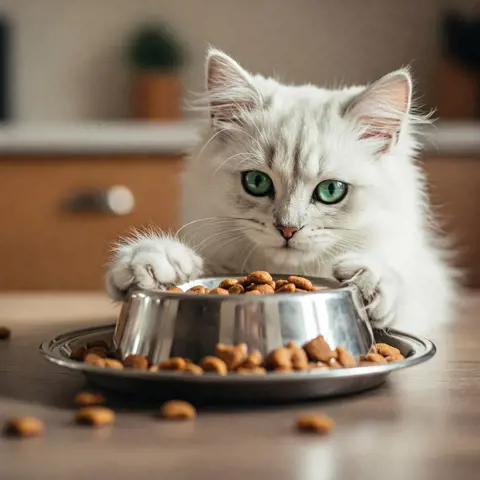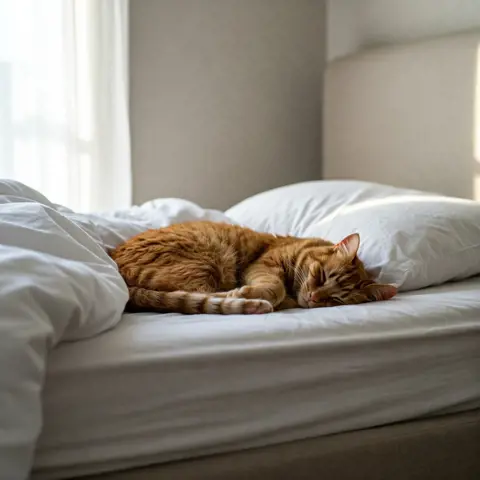Why Does Your Cat Scratch Around the Food Bowl? Understanding the Behavior and What It Means

In This Article
The Behavior: Why Cats Scratch Around the Food BowlIs Scratching Around the Food Bowl Cause for Concern?
Addressing and Reducing Scratching Behavior
Understanding Your Cat's Emotional and Health Needs
Conclusion
If your cat keeps scratching around its food bowl, you're probably wondering what’s going on. The good news is, this quirky habit is often tied to natural instincts like “burying” food for later or marking territory. While it might seem odd, it’s usually harmless. However, in some cases, it could hint at stress, pickiness, or even a health issue. Understanding why your cat does this is the first step to ensuring they’re comfortable and content during mealtime.
The Behavior: Why Cats Scratch Around the Food Bowl
If your cat regularly scratches around its food bowl, you might have found yourself scratching your head too. This behavior, though seemingly unusual, stems from a combination of natural instincts and environmental factors. Whether it's covering food out of habit, marking territory, or signaling discomfort during mealtime, understanding the "why" behind these actions can help you better cater to your feline friend.
Burial Instincts in Cats

From a young age, cats are hardwired with instincts linked to survival. One of the primary reasons your cat might scratch near their food bowl is rooted in their wild ancestry. Cats in the wild often bury excess food to hide the smell from predators or competitors. While your cat's kibble is safe in your home, the habit remains.
This behavior serves as a simulated "burial," where your cat mimics covering up their food using imaginary dirt. They might paw around their food dish or even try to flick loose items from a mat. It’s not that they dislike the meal—it’s just in their DNA. If you'd like to know more about why cats exhibit this instinctive behavior, check out this comprehensive guide to cats burying their food.
Territorial Marking and Ownership
Cats are territorial creatures, and mealtime can sometimes become a display of control. When they scratch near or around the food bowl, they could be leaving their scent behind. Cats have scent glands in their paws, and these subtle markings let the "world" (or other pets in your home) know that the food belongs to them.
While this behavior isn't typically aggressive, cats may "claim" their area out of instinct to ensure no one else sniffs out their stash. Interestingly, this form of territorial marking is less about dominance and more about creating a sense of ownership and security. Studies suggest that this is common when there are other pets or cats in the household. For additional insights into territorial cat behavior, consider reading why cats scratch around for ownership.
Stress or Discomfort During Mealtime
A more concerning reason for scratching behavior might be tied to stress or discomfort. Cats, like humans, can become agitated by environmental factors during meals. If your cat's eating area is loud, chaotic, or located too close to other pets, it could cause your pet to scratch as a sign of unease.
Stress-related scratching is often mixed with other signals like hesitating before eating or walking away after a few bites. It might also occur if your cat associates certain smells, bowls, or locations with discomfort. Addressing these issues could involve finding a quieter spot for their food or experimenting with different bowls that are more inviting. Learn more about calming stressed cats during meals from this helpful guide.
By recognizing these potential stressors, you can take steps to create a more comfortable and peaceful dining experience for your cat. After all, happy cats are more likely to enjoy their meals without unnecessary behaviors interrupting their routines.
Is Scratching Around the Food Bowl Cause for Concern?
When your cat scratches around its food bowl, it might strike you as odd, maybe even irritating. But not every scratch is a red flag. Sometimes, it’s simply part of their instinctive charm. Other times, persistent or unusual behavior might indicate something’s off. Let’s break it down into what’s normal, what isn’t, and how your cat’s environment might come into play.
When Scratching Is Normal

In many cases, scratching around the food bowl isn’t something to worry about. Cats are hardwired with behaviors passed down through generations, even if they no longer serve a practical purpose at home. What does this mean for you? It’s simply part of their DNA.
Your cat may scratch the floor or paw at nearby objects as a way to “bury” uneaten food, mimicking wild behaviors. For feral cats, this helped hide food from other animals or predators. Similarly, scratching near the area could mark the spot as their territory since cats often release scent through their paws.
- It’s instinctive: Indoor cats inherited these behaviors, even if no threat exists in your home.
- It’s their version of storage: By “covering” food, they might be signaling, “I’ll save this for later.”
- It’s harmless: Unless accompanied by unusual stress or refusal to eat, it’s safe to chalk this up to being quirky.
Of course, every cat is unique, and context matters. Keeping an eye out for changes is key.
Signs of Potential Health Issues
While occasional scratching is perfectly normal, sometimes it can signal something isn’t right. If you notice excessive or frantic scratching, changes in eating habits, or a refusal to eat altogether, it’s time to take a closer look. Cats are experts at masking discomfort, so keeping an eye on their behavior is important.
- Excessive pawing: If your cat scratches obsessively around the bowl, it might be reacting to an illness.
- Avoidance: Refusing to eat could indicate dental pain, nausea, or other health issues.
- Other symptoms: Watch out for vomiting, lethargy, or weight loss; these are signs your cat isn’t feeling well.
If you have doubts, consider reaching out to a veterinarian. More often than not, what may seem like a minor behavioral tick could be tied to physical discomfort or stress. Read this article on why cats may not eat and what you can do about it.
Furthermore, dissatisfaction with their food can also cause scratching behavior. Cats can be picky eaters, and if the dish isn’t to their liking, they could show their discontent through scratching. Learn more signs of dissatisfaction in this guide on reading your cat’s food preferences.
Environmental Factors at Play
Your cat’s surroundings play a significant role in their eating habits. The setup of the feeding area—along with environmental stressors—can make or break their comfort levels. Scratching could be your cat’s subtle way of saying something isn’t right.
What could be triggering this behavior?
- Bowl placement: If the food bowl is near high-traffic areas, noisy appliances, or tucked in a corner, it may make your cat uneasy.
- Cleanliness: Cats are meticulous creatures. A dirty bowl or feeding mat might cause aversion to the area.
- Sharing stress: In multi-pet households, cats might feel the pressure to “protect” their meal, especially if sharing the space.
One simple solution? Try relocating the feeding station to a quiet, distraction-free area. Cats prefer calm and predictable environments, especially during vulnerable times like eating. If you’re curious about how these factors intertwine with feline behavior, this article on environmental impacts offers deeper insights.
At the end of the day, your cat’s scratching could be its way of signaling that something doesn’t feel quite right. Observe, try minor adjustments, and consult a professional if needed. When in doubt, tweaking their environment might go a long way in promoting happier, more peaceful mealtimes.
Addressing and Reducing Scratching Behavior
Scratching around the food bowl can be frustrating for pet parents, but it’s a behavior that can be addressed with a few thoughtful changes. Simple adjustments, from rethinking the feeding setup to understanding your cat's preferences, can make a big difference. Here’s how you can tackle this behavior in a way that keeps both you and your feline happy.
Optimizing the Feeding Area

Creating a calm and practical environment for feeding is critical. Cats can be sensitive to their surroundings, so consider these tips to improve their eating experience:
- Use anti-scratch mats: These mats shield the floor while discouraging scratching behavior. They also make cleanup easier. Check pet stores for mats designed specifically for messy eaters.
- Elevated bowls: Elevating the food bowl can help prevent strain on your cat’s neck while eating. It also minimizes mess and tends to look more inviting for fussy eaters. Read more about why this works in the Ultimate Guide to Elevated Cat Bowls.
- Place in a quiet area: Cats prefer eating in quiet, low-stress environments. If their bowl is located near loud appliances or in high-traffic areas, try moving it to a calmer corner of your home.
By making these tweaks, you can eliminate some of the triggers that lead to scratching and create a more enjoyable mealtime experience for your cat.
Evaluating Food Preferences
Scratching around the food bowl could be your cat's way of saying, “This isn’t quite what I wanted.” Cats can be selective eaters, so it’s important to pay attention to their reactions to different types of food.
Here’s how you can assess and address their preferences:
- Observe eating habits: Does your cat eat happily or take a few bites and walk away? If they seem hesitant, they might not be thrilled with the taste or texture of their food.
- Switch flavors or brands: Experiment with varying flavors, textures (wet vs. dry food), and even different brands to find what your cat enjoys most. Learn more about decoding food preferences here.
- Read food labels carefully: Ingredients matter! Aim for high-quality protein sources and avoid fillers or artificial additives. This guide to deciphering cat food labels can help.
Remember, cats often have strong opinions about their meals, and their scratching behavior might decrease once you find what works best for them.
Training Techniques and Positive Reinforcement
Adapting your cat's behavior doesn’t have to be stressful—for you or your pet. Cats respond well to gentle training paired with positive reinforcement, which encourages good habits without causing frustration.
Here are a few strategies to consider:
- Redirect their energy: If your cat starts scratching near the bowl, gently redirect their attention using toys or verbal cues. Over time, this teaches them to stop the behavior.
- Reward good behavior: Offer praise, pets, or the occasional treat when your cat eats calmly without scratching. Positive reinforcement works wonders.
- Avoid punishments: Cats don’t respond well to scolding, and it could create anxiety. Instead, focus on reinforcing the behaviors you want to see.
These training techniques take patience but can help create a more peaceful mealtime for everyone involved.
Understanding Your Cat's Emotional and Health Needs

Cats aren’t always transparent when showing us how they feel, especially when it comes to stress or potential health concerns. As a cat owner, knowing how to interpret your pet's subtle cues during mealtime can greatly improve their well-being. Whether it’s creating a calm feeding environment or keeping tabs on their eating patterns, understanding your cat's emotional and health needs will help you respond to their behavior effectively.
Recognizing Stress and Anxiety in Cats
Cats may be creatures of habit, but even minor changes in their daily environment can cause stress. Recognizing when your cat feels insecure—especially around mealtime—is crucial. Stress in cats often manifests through body language or subtle behaviors, and mealtime can be a vulnerable moment for them.
Here are common signs of stress during meals:
- Tense body posture: Your cat may hunch up, flatten their ears, or flick their tail repetitively.
- Food refusal: Cats experiencing anxiety might walk away from their food after sniffing it.
- Scratching or clawing nearby surfaces: This could indicate restlessness or an attempt to mark territory as a way to feel secure.
To make mealtime more soothing:
- Choose a quiet location for their food bowl. Avoid bustling areas like kitchens or hallways so they can eat in peace.
- Stick to a routine. Cats thrive on consistency. Serving their meals at the same time every day can provide comfort through predictability.
- Use calming aids if necessary. Products like pheromone diffusers or sprays can significantly reduce stress during meals.
Understanding what stresses out your cat and eliminating those triggers can make a world of difference. For more tips on identifying signs of cat stress and relief techniques, check out this helpful guide by Cats Protection.
Health Monitoring During Mealtime
Mealtime offers more than just an opportunity to feed your cat; it’s also the perfect time to monitor their overall health. Paying close attention to their eating habits might reveal early warning signs of physical discomfort or illness.
Here’s what to watch for:
- Changes in appetite: If your cat is eating significantly less (or more) than usual, it could indicate underlying issues like dental problems or thyroid imbalances.
- Picky eating behaviors: Refusal of previously loved food may suggest gastrointestinal discomfort or that the food itself has gone stale.
- Abnormal behaviors while eating: Signs such as drooling, excessive pawing at their face, or walking away mid-meal may point to dental pain or difficulty swallowing.
In addition to monitoring at home, scheduling routine wellness check-ups with your veterinarian is vital. Annual exams can help identify any unnoticed health risks and keep your cat on track for a long, happy life.
Don't ignore small changes—they often indicate something more significant beneath the surface. Learn more about spotting potential health issues during mealtime with this guide from Blue Cross.
By blending empathy and observation, you can ensure your cat’s emotional and physical needs are fully met, making every mealtime a positive experience.
Conclusion
Understanding why your cat scratches around their food bowl can transform how you approach mealtime with your furry friend. Whether it’s linked to natural instincts, environmental stress, or personal preferences, this behavior is often more about communication than cause for alarm.
Pay attention to their habits, make small changes to their feeding setup, and consult a vet if something seems off. These simple steps can improve not just their eating experience but their overall happiness.
Your cat’s quirky behaviors often have a purpose—no matter how perplexing they seem at first. By staying patient and observant, you’re building a stronger bond and creating a more comfortable home for your pet.
Frequently Asked Questions
- Why does my cat scratch around the food bowl before eating?
- Cats might do this because of their natural instinct to bury food for later. In the wild, cats often cover uneaten food to save it or hide the scent from predators.
- Is scratching around the food bowl a sign of dislike for the food?
- Not necessarily. While it could mean your cat isn’t interested in the food, it’s more likely tied to instinctual behavior rather than a dislike for the meal itself.
- Could this behavior mean my cat is hungry or full?
- Scratching doesn’t usually indicate hunger or fullness. It’s more about instinct and habit, though some cats might scratch when they’re full to mimic burying leftovers.
- Does my cat think the food bowl is dirty?
- No, cats scratching around the bowl aren’t trying to clean it. It’s unlikely they associate this behavior with cleanliness.
- Should I be concerned if my cat keeps doing this?
- In most cases, no. It’s harmless and natural. However, if the behavior seems obsessive or your cat stops eating altogether, consult your vet.
- Can this behavior damage my floor or furniture?
- If your cat scratches persistently around the bowl, they could damage nearby furniture or flooring. Consider using a mat under the bowl to protect surfaces.
- How can I discourage my cat from scratching?
- Try feeding your cat on a different surface, like a non-slip mat, or move the bowl to a quieter spot. Providing toys or scratchers nearby might help distract them.
- Is this behavior more common in some cats than others?
- Yes, it’s more common in cats with strong territorial or nesting instincts. Individual personality and breed can play a role as well.
- Does scratching around the food bowl indicate anxiety?
- Sometimes. If your cat scratches excessively and seems stressed, anxiety could be a factor. Watch for other signs of stress like hiding or vocalizing excessively.
- Should I change my cat’s bowl if they scratch around it?
- Not usually. Scratching isn’t related to the bowl itself, but if the current bowl seems uncomfortable for your cat (too deep or too shallow), trying a different one won’t hurt.
- Can this behavior be linked to a medical issue?
- Rarely. But if scratching is paired with other unusual behavior (like vomiting or loss of appetite), contact your vet to rule out medical concerns.
CatsLib.com relies on trusted, high-quality sources, including peer-reviewed research, to back the information in its articles. We regularly review and update our content to ensure it remains accurate and reliable.
If you have concerns about your pet's health or any medical questions, we highly recommend consulting a qualified veterinarian. The information on this site is for general informational purposes only and should not be used as a substitute for professional advice, diagnosis, or treatment.
How We Ensure Accuracy
At CatsLib, we take the accuracy of the information we provide very seriously. Our content is created and reviewed by experts to ensure that every piece of advice is not only helpful but also based on the latest veterinary research. Here’s how we make sure the information you read is reliable:
- ✔ Content reviewed by certified experts
- ✔ Based on up-to-date veterinary research
- ✔ Reviewed regularly for relevance and accuracy
Recent Articles

Why Are Siamese Cats Cross Eyed? Genetics, Health, and Care Guide

Do Ragdoll Cats Shed a Lot? Seasonal Tips to Manage Fur and Keep Your Home Clean

10 Medical Reasons Your Cat Is Walking in Circles – Signs You Should Never Ignore

Why Does Your Cat Scratch Around Its Food Bowl? Top Reasons and Simple Solutions

